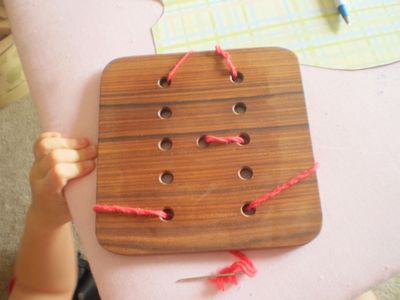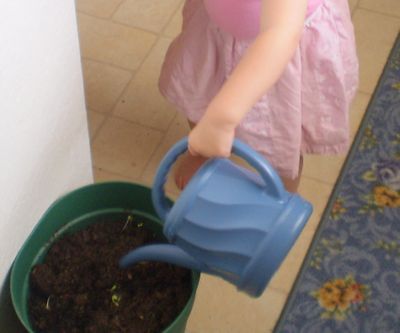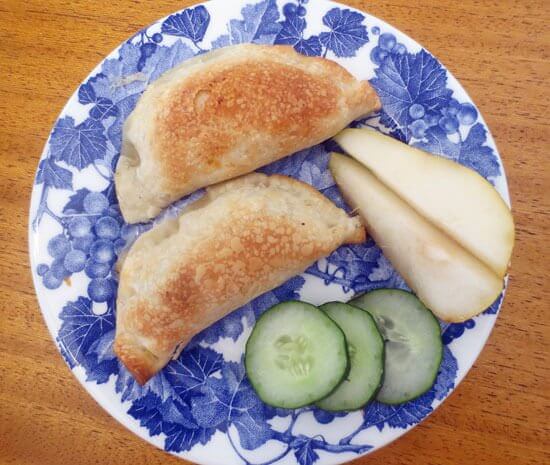Waldorf-Inspired Real Play
While we don’t specifically use Waldorf methods in our home (simply because I’ve never studied about it myself), I think that there are a lot of similarities in our philosophy of how we would like our children to learn and play, especially as home educators. I’ve really enjoyed learning more about the Waldorf method from guest poster Cara!
*******

Waldorf is a method of education founded by Rudolf Steiner in the late 1800s that focuses on a natural approach to child development. While we don’t use everything from the philosophy (it goes into some religion stuff that we don’t agree with), we do really like the approach to early childhood education. Steiner advocates allowing children to develop in a natural environment with a focus on the natural rhythms of home life. In this philosophy of childrearing, children live their lives with purpose, imagination, and love.
I learned about this method of education when the daycare that I worked at four mornings a week as a teen underwent transformation from a regular daycare into a Waldorf preschool. I was amazed to watch some of the daycare children turn from hyperactive, easily distracted, and easily bored to calm happy kids with an excellent attention span. The play they engaged in was now Real Play, play with more meaning that mimics what we do in every day life.
The following are some things that we do to facilitate Real Play in our home. It seems almost too simple, but it is quite enriching
Starting with my little babies, I help them to be a part of every day life by playing near me on the floor, and when they want to be held they ride on my hip in a sling, or on my back in a mei tai or Ergo. I chatter about what I’m preparing for supper, sing little nursery rhymes, and give lots of smiles while allowing them to see what goes on in every day life. Letting them see you always being engaged in something, rather than just passively being entertained (on the computer or TV) helps prevent boredom through example. When I am sitting and listening to the radio or just having a conversation with my hubby, if I’m not nursing a baby, I try to have some handwork to do, like knitting or hand sewing.
We don’t allow screen time of any kind for children. No videos, no cartoons, no computer games. I’m not a purist, my daughter has seen me on the computer and she has seen cartoons at other people’s house. But as a general rule, we stay away from that, so that she doesn’t get conditioned to where she needs something to watch to be entertained. You will find that once your child develops a long attention span, they are happy to play alongside you while you work and you will not depend on the TV to keep them entertained while you accomplish your chores.

I make a point to slow down what I’m doing and do things with purpose so my little ones can see and imitate me, since that’s what they do naturally. I don’t rushidly fold the laundry. I carefully smooth out each shirt, fold it, and place it in the stack. I take care to place my dirty dishes in the sink, then gently wash them. I avoid looking as if I’m a chicken with my head cut off as I rush around to catch up on housework. I smile as I work. Really, it doesn’t take much more time at all, and it gives the children something to imitate. This work is your quality time with the children, young children especially enjoy an activity like making bread with mom just as much (or in our case more!) than a trip to the fair or amusement park. It shows them by example how to care for belongings, to find contentment in what must be done, and it gives them peace of mind to know that Mommy isn’t frazzled.
When possible, I involve my children in my work. It takes a little longer, but my toddler receives much more joy in completely emptying the dryer into the laundry basket for me than she would with a dozen ‘Good Job!’ stickers. I also pay attention to what will trigger a meltdown and avoid it. For instance, my little girl isn’t happy just putting the two cups of flour in my cookie batter; she wants to scoop the entire flour canister into the mixing bowl. So, knowing this, scooping the flour is something that just Mommy does for now, and she has a bin full of rice and scoops where she can scoop to her heart’s content. When helping isn’t possible because of safety (like with sewing) or the tendency to trigger a meltdown, I do try to provide some similar alternative for her, again, encouraging her desire to imitate me.
We sing little songs throughout the day. Children love repetition and silly rhyming songs. A verse of “This is the way we wash our hands” before lunch or after playing outside makes hand washing into a pleasurable experience rather than a chore. A little song can convince a reluctant toddler to do what needs to be done as well, “This is the way we buckle our carseat, buckle our carseat, buckle our carseat…”

Waldorf puts emphasis on outside time as well. And to allow children’s imagination to flow, unstructured open nature areas are encouraged over playgrounds with play structures. On play structures, children are confined to what is there. In a natural park setting, children have more of an opportunity to notice small things. They watch the ants trailing out of the ant hill. They collect pine cones. They make mud pies and daydream.
Natural toys are preferred, but if those are not available due to money constraints, open-ended toys are the best. The more specific a toy is, the faster a child will get bored with it. Open ended toys are toys that can perform a variety of purposes. A basket can be a bathtub one day, an oven for baking bread the next, and also turned upside down, covered with a playsilk, and used as a stage for a play the next day. By contrast, a flashing box with buttons that talks and tells the child what to do is limited to its one specific roll, and quickly becomes boring. Having few toys is preferred to having many. With many toys out, the child is overwhelmed and stops playing with them in search of more order and simplicity.
My first summer job as a daycare assistant greatly influenced how I parent my children and live my life. I learned to slow down and appreciate the little things with children. I learned that faster isn’t always better. I learned that children don’t need to be constantly busy to be happy. And I learned that children weren’t nuisances to be ‘kept busy’ until they could be taught later on, but they were to be joyously included in every day life right along side an adult. I wanted to share since I feel that what I’ve learned has enriched our family life, and I hope it can enrich yours as well.




I really appreciate this article. I never thought of playtime and learning in this way. It’s hard to remember the simplicity of my own youth with all the gadgets and electronic devices that we have now. But when I think back I did have a wonderful imagination as a child and I didn’t have a computer or too many fancy toys.
I think it’s wonderful that you don’t rely on television to “babysit” your children and in essence it really is “babysitting” their brains. I hope to have that discipline when I am a parent.
It is so true that children watch their parents and learn from them. A parent’s negative comments and negative dispostion/attitude toward work, chores, or anything else teaches the children to not to be positive, hardworking, and thankful.
This sounds just right for our family. It is sort of how we do things now – no screen time, lots of participation in every day chores and activities, songs, reading, organic learning really.
Thanks for the article!
Thanks for the opportunity to guest post!
I didn’t realize there was a name for what we do everyday. Although I think we probably need to cut back on “screen-time”–sometimes Baby Einstein is a lifesaver (like when I need a shower). I also have a 2-1/2 year old and an 8 month old. Great Post.
I love this post.
I love the gentleness that it reminds me of.
I love the fact that by being gentle and involving our children in real life they are growing and learning so much.
God Bless
The Waldorf method…I’ve never heard of it, but it sounds a lot like how my husband and I want to raise our kiddos and that it would naturally compliment homeschooling, when that time comes. I loved this post! Thank you!
Although I had never heard as much info on Waldorf style living as this, we do many of the same concepts in our own home. It does get a bit complicated, however, as others expose my oldest to other things- like toys as gifts, for example, that don’t fit with our philopsophy (like ones with batteries that only do one thing). We prefer to keep things simple too. The only thing that I find hard is that all of this requires A LOT of patience, which I am lacking in, and continue to pray for more of! Thank you for sharing!
Thanks for this post. We do not practice Waldorf style exclusively (also lack of studying it), though I do try to incorporate certain parts that I already knew about, like the toys. I do love your description of slowing down our work and letting our children work with us, so that is something I am going to work at doing. Thank you for the tutorial for the waldorf doll. I have been wanting to make one for my children for eons but they so intimidating! Thanks again!
About gifts, I usually let my kids play with battery operated gifts for a couple days until they get bored with them, then move them on to the local rescue mission thrift store. If it was something that I really objected to (like video games or Barbies) I’d graciously accept, explain later if appropriate, and then move them on right away.
I’m the parent, and I feel it’s my job to put my children’s needs above the ego of a gift giver, so I don’t have any problem doing this. We also live in a pretty small place, so it’s easy to use the excuse of ‘rotating toys through since we don’t have room to have them all out at once’
I’m glad that people enjoyed my article 🙂
I really enjoyed this post…thanks for sharing! We also do a lot of these things around our house- no screen time, no toys with batteries, lots of imitation of real life. I also need the reminder to slow down though. I loved your thought of working with a smile and not just running around frantically getting things done. I am far too task-oriented. Great reminder of what is important!
I really liked this post as it puts into perspective every day “chores” as something that is truly valuable in the home! We do this with our children (well, with my 2 yr old, baby is only 6 mo:) but although there are some similarities between Waldorf & Montessori, we lean more on the Montessori side. We also don’t let them watch TV unless (he) is sick and lying on the couch for the day.
Our big thing is teaching independence through help with chores like: laundry,feeding pets, gardening, cleaning, baking & cooking and then some free play. The most astounding thing to most people is they WANT to help! Kids are such eager learners and we are robbing them of life skills when we shoo them away everyday. (I say everyday bc sometimes it is just really hard when you need to get something done in a hurry! But most of the time, my Bug is around, scooping flour into the mixing bowl or taking the laundry & putting it into the clean basket. He loves it, and he already understands instructions for these things, too, which is a big help!! We started doing this with him around 15 months (he was easily walking by then).
I embrace Montessori’s viewpoint of ‘child-sized’ utensils and then learning through trying/observation (which is how my Bug learns best). I SO ENJOYED this article! I love the gentleness & simplicity these types of educational basis encourage and thanks for the waldorf doll post–I was planning on making him something like that for xmas! 🙂
Sarah M
Thank you for this article. I appreciate waldorf inspired education for my kids and my family.
I’m so rushed all the time. I really do need to slow down and allow the kids to help more. I cringe when I think of all the times my kids have asked me if they could help with something and I’ve said, “no” onluy to have them trot off and play the Wii.
I’ll be chewing on this post for a long time. Thank you.
Sandy
LOL, I had nooooo idea there was a name for this type of childhood education! My parents did this with us, but I always just figured it was their California Hippie roots that influenced their parenting – no clue there was a whole philosophy!;) My husband and I both like the principles behind Waldorf … esp. the idea of making toys meaningful and imaginative, limiting TV and LOTS of playing outside. We have only one daughter who is just seven months, so I haven’t really developed a educational routine with her yet. However, I have been convicted recently that I really need to make sure that MY “screen-time” is limited and appropriate for her hearing/viewing.
Anyone have suggestions for implenting a Waldorf-type approach with 6-12 month olds??
Thanks for the fantastic post!
My question is what do you do with toddlers when outside isnt really an option (it rains far to much where I live) and you live in a small apartment?
How does Waldorf differ from Charlotte Mason type of schooling/living? She is also very have the children help, outdoor play and so on. Very hands on. We follow a lot of her methods here and it seems a lot of Waldorf.
Thanks,
Beka, I got my hippie roots from California too 😉 We transplanted to Montana before having children, but we have some California roots going on here. 6-12 month olds.. Just having them watch everything you do from a sling or Ergo. I let mine (9 months now) play with a spatula when I’m cooking, and just let him see everything that goes on with the housework rather than waiting til he goes down for a nap to cram it all in. Going for walks, enjoying the outdoors, just spending time together and avoiding the overstimulation of electronic toys and TV.
Jessica, we live in a small apartment too right now, in Montana where there’s bad weather for a good portion of the year. I just keep her (3 next month) with me, set her up on the counter when I’m mixing bread, let her squirt the bottle of vinegar when I’m cleaning, give her a rag to work along side me when I’m wiping down the cabinets, empties the dryer of clothes, stacks her brother’s diapers, etc. We do a lot of cooking from scratch, so there’s plenty of dough to play with, potatoes to wash, silverware to be put away. She does a lot of imitation with her baby doll when I’m caring for her little brother as well. To go to the park, we are fortunate that we have 3 within walking distance. Even if it’s too bad of weather to go to the park, we do go outside to get some fresh air and a little walk in, as long as it’s above 15 degrees. We just bundle.
Jessica O, I’m not quite sure how Waldorf differs from Charlotte Mason. I just heard of CM a couple years ago (with the book Real Learning, I love that book!). From what I’ve read about it, I think I actually prefer Charolette Mason’s educational model to the Waldorf one, but my only experience in early childhood is with Waldorf, not CM. Confusing? Sorry I don’t know more about the differences!
Love the talk of hippy roots! I am a California native and still living here. I was raised in a very “crunchy” area, where we lived outside, rain, snow, or shine. I love the approach and philosophy of Waldorf, yet have felt guilty sometimes at admiring it because of some of it’s religious/other beliefs, however, this post was very encouraging that others are “taking it with a grain of salt”!
I have two boys and they spend most of the time outdoors. We limit screen time to 30 mins a day (just for my 3-yr-old), we don’t have cable television and they both have never had a problem entertaining themselves.
The hardest has been trying to stick to natural/ open ended toys as the Montessori and Waldorf type toys are so expensive, however, we do have a no battery-operated toy rule and I also have special baskets throughout the house with random normal items (old bracelets, cardboard shapes, felt “frisbees”, etc. These are always a hit and when I put my imagination into it!
The most important is the outdoor time and although I live in a mild climate, we have been known to go out in the rain often on nature walks… always bring a bucket or bag for things for them to find as treasures… my boys LOVE it!
Great post!
Congrats on the new little one!
I pray you are able to get enough rest!
I’m hosting a giveaway to celebrate my 1yr anniversary!
I love to meet new blog friends and people that share things in common! And people I can learn things from!
I’m a Momma of 6 kiddos so far! We practice Attachment Parenting and homeschool on and off! I will have my 2nd grader home next year as well as a preschooler and my 2 yr old!
Come by and say hi and check out me giveaway!
Blessings,
Georgiann
I enjoyed reading this post. I had heard of Waldorf before when one of my music instructors started a Waldorf pre-school and she asked me to make some natural toys for it. When I talked with her about it, I thought it sounded fun but I also laughed a little because she was opening this expensive pre-school to offer to kids what I did with my kids every day at home. Home is the very best place for this kind of education!
Abbi, I totally agree that home is the best place for education and raising children 🙂
Jodi, for toys we’ve found great ones inexpensively at antique stores and garage sales. We also make a bunch. The book Toymaking With Children has lots of ideas that are pretty easy for anyone to do.
Just discovered your lovely blog and was delighted to see a reference to my company, Bella Luna Toys, as a source for Waldorf-inspired toys! I read this lovely article on Waldorf-inspired play. As a long-time Waldorf early childhood educator, author and former homeschooler, I thought I’d also point your readers to an interview I recently did with another blogger in which I tried to describe Waldorf early childhood education in a nutshell: http://www.bellalunatoys.com/customerservice/wee-folk-art-interview.htm
Keep up the good work!
Sarah Baldwin
I love your craft projects and your ethos, I see a lot of myself in them. I had never heard of Waldorf but it is fascinating and virtually what I do with my 9 month old. Not often you happen upon a site so warming to the soul. I’m definitely going to make a little dolly. Keep up the good work, you must be a lovely mom, I got that old fashioned “good life feeling” and am going to pick up my knitting when I sign off!
Thank you for this information about the Waldorf method. I really liked what you said about toys, and I have found it to be true. Also the whole idea of “no screen time”—do you have any ideas for weaning kids off of this? One of my kids is so hooked on tv that he doesn’t really know how to entertain himself and he drives everyone else crazy moping around, whining, and refusing to participate in whatever everyone else is doing.
My daughter is an au pair for a family who is raising their children using the Waldorf method. I’m trying to figure all this out since it is new to me. Can someone tell me about the cat that comes in the middle of the night and eats all the toys that have not been put away? My daughter didn’t know anything about this cat when she told the kids it was time for bed while some toys were still laying about. The kids became hysterical. She later learned it was a Waldorf thing???